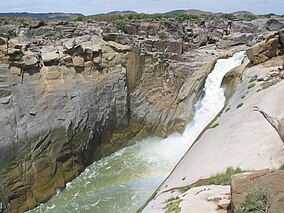류샤 강(피질 강)
Liusha River (fictional river)| 흐르는 모래 강 | |
|---|---|
| 네이티브 이름 | 流沙河 (중국어) |
| 물리적 특성 | |
| 길이 | 1만 마일의 중국 거리 |
| 폭 | |
| • 최대값 | 중국말로800마길 |
류샤 강(중국어: 流沙河, River of Flowing Sands, Flowing-Sand River)은 중국 소설 '서부로의 여행'에 나오는 가상의 강이다.[3] 그 강은 <서부로의 여행>의 22회에서 찾아볼 수 있다.[4][5] 소설에 나오는 류샤 강의 원형은 현재의 신장 카이두 강이다.[6]
이 강은 중국에서 선우콩과 다른 순례자들이 우청겐의 서부 여행에서 인도로 여행한 마지막 명소였다.[7] 이 소설의 22화에는 이렇게 묘사되어 있다.[8]
- 류샤 강의 폭은 800리, (八百流界)
- 그리고 그것의 물은 빠르고 매우 위험하다.(三千弱水深)
- 류샤 강에는 거위 깃털이 떠 있지 않는다, ( (鹅飘不)
- 그리고 갈대꽃은 강바닥으로 가라앉을 것이다.(芦花定底沉)
흐르는 모래 강은 길이가 만 리, 폭이 팔백 리나 된다.[9]강의 거장은 사오정, 옥황상제의 Curtain-Rolling 장군(卷帘大将)은 헤븐리 궁전(天宫)[10]에 나오면서 세속적인 세상 때문에 실수로 플랫 복숭아 회의(蟠桃会)에, 따라서 법 하늘(天条)[12]위반[11]는이 물 괴물은 유리 컵(玻璃盏)을 추방되였습니다그는 Liusha RIver.[13] 후에, Guanyne은 그를 깨우쳤다.그리고 류샤 강에서 경추( (经人)들이 자신을 제자로 받아들이러 오기를 기다렸다.[14] 이후 불교로 개종하여 당생(唐生)의 세 번째 견습생이 되었다.
참고 항목
참조
- ^ Wu Ch'êng-ên (1 December 2007). Monkey: Folk Novel of China. Grove Atlantic. pp. 163–. ISBN 978-0-8021-9884-6.
- ^ Anthony C. Yu (5 April 2013). The Journey to the West, Revised Edition. University of Chicago Press. pp. 432–. ISBN 978-0-226-97140-7.
- ^ Research on Ancient Chinese Novels, Volume 1. People's Literature Publishing House. 2005. pp. 254–. ISBN 978-7-02-004983-7.
- ^ "Traveling on the Silk Road with Journey to the West". Xinhua News Agency. 2016-03-22.
- ^ "Where are the magical places in "Journey to the West"?". Duowei News. 2015-06-26.
- ^ Muqi Che (1989). The Silk Road, Past and Present. Foreign Languages Press. pp. 201–. ISBN 978-0-8351-2100-2.
- ^ Ann Elizabeth Barrott Wicks (1998). Painting Paradise: The Art of Ting Shao Kuang. China Books & Periodicals. pp. 24–.
- ^ Wu Cheng'en (2003). Four Great Classics/Volume One/Journey to the West. Jinghua Publishing House. ISBN 978-7-80600-111-0.
- ^ Cheng Jun Yi (2004). Sun Wukong is a Good Employee: 28 Professional Proverbs from the Journey to the West. CITIC Press. pp. 117–. ISBN 978-7-5086-0263-9.}
- ^ Edward Theodore Chalmers Werner (1956). Myths and Legends of China. Library of Alexandria. pp. 277–. ISBN 978-1-4655-8092-4.
- ^ Wu Cheng'en; Li Zhuowu (1 June 2006). Li Zhuowu Criticism of the Journey to the West. Yuelu Publishing House. pp. 907–. ISBN 978-7-80665-728-7.
- ^ Kuang Chen; Pan Liang (2006). Our 1980s. China Friendship Publishing Company. pp. 166–. ISBN 978-7-5057-2274-3.
- ^ "Why did Sha Wujing wear a necklace with nine skulls?". China Times. 2015-06-07.
- ^ Cheng Fan (1 January 2011). Four Masterpieces of Chinese Classical Literature: Children's Edition. Jilin Publishing Group Co., Ltd. pp. 10–. ISBN 978-7-5463-4555-0.


